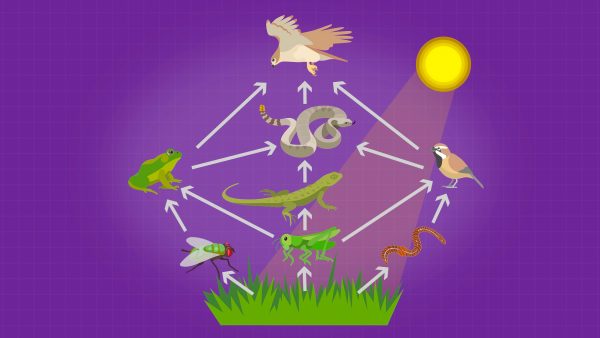Invasive Species Definition
An invasive species is a plant or animal that is not native to a given area. For example, a plant introduced by humans can grow unchecked, impacting native species.
View Lesson on Competition in Ecosystems
Become a member to get full access to our entire library of learning videos, reading material, quiz games, simple DIY activities & more.
Become a member to get full access to our entire library of learning videos, quiz games, & more.
Plans & Pricingto watch this full video.

Access All Videos
and Lessons, No Limits.
Access All Videos

No credit card required,
takes 7 sec to signup.
No card required

Ready-to-go lessons
that save you time.
Ready-to-go lessons
If you are on a school computer or network, ask your tech person to whitelist these URLs:
*.wistia.com, fast.wistia.com, fast.wistia.net, embedwistia-a.akamaihd.net
Sometimes a simple refresh solves this issue. If you need further help, contact us.
Competition in Ecosystems
Fun Facts
- Feral pigs are an invasive species that were introduced by early explorers as a food source.
- Animals can spread seeds of invasive species to non-native areas via fur or waste.
- Invasive species can be accidentally or purposely carried by humans.
Why Do We Need To Know About Invasive Species
Learning about invasive species helps us understand how important it is to keep ecosystems balanced and protect different kinds of life. Invasive species are plants or animals that humans have brought to new places, often by accident, where they can harm local plants and animals. A good example is feral pigs that can cause a lot of damage. It’s important to manage these invasive species to keep nature in balance.
Wildlife biologists are very important in dealing with invasive species. They keep an eye on how these species affect local wildlife and the environment. They help control the number of these invasive species and sometimes even find new species. Their work is very important for protecting nature and shows how studying ecosystems can be used to solve real-world problems.
Frequently Asked Questions
Check out the Full Lesson on Competition in Ecosystems
In this lesson, we learn that:
- All living things compete for resources like food, water and shelter.
- Competition can affect the growth and survival of organisms.
- Changes in an ecosystem can also effect which organisms survive.
Related Topics
- Biochemistry Definition
- Carnivore Definition
- Cast Fossils Definition
- Chemical Reaction Definition
- Chloroplast Definition
- Circuit Definition
- Competition Definition
- Dissolve Definition
- Divergent Boundary Definition
- Earth’s Axis Definition
- Ecosystem Definition
- Electric Charge Definition
- Electric Field Definition
- Electromagnetic Radiation Definition
- Engineering Design Process Definition
- Exoskeleton Definition
- Gas Definition
- Germination Definition
- Igneous Rock Definition
- Inclined Plane Definition
- Inherited Traits Definition
- Invasive Species Definition
- Landslide Definition
- Lever Definition
- Metamorphosis Definition
- Newton’s 2nd Law Of Motion Definition
- Non-renewable Energy Definition
- Non-renewable Resource Definition
- Nucleus Definition
- Opaque Definition
- Photosynthesis Definition
- Predation Definition
- Prey Definition
- Problem Definition
- Properties Of Matter Definition
- Rain Definition
- Renewable Energy Definition
- Respiratory System Definition
- Rock Definition
- Senses Definition
- Solar System Definition
- Star Definition
- Sun Definition
- Tides Definition
- Tsunami Definition
- Water Distribution Definition
- Wedge Definition
- Weight Definition
Start a Free Trial Today. Get a $5 Amazon Gift Card!
Teachers! Start a free trial & we'll send your gift card within 1 day. Only cards left. Try it now.
Select Grade
Select Subject
This email is associated with a Science Kit subscription. Kit subscriptions are managed on this separate page: Manage Subscription

-
Download InvoiceScience & Math$/yr
-
Download InvoiceScience Only$/yr

access all lessons
• No credit card required •
"My students loved the videos. I started the video subscription in May and used them as a review before the state test, which I know contributed to 100% of my class passing the state test."
Rhonda Fox 4th Grade Teacher, Ocala, Florida
Use Generation Genius in Your School
Access all lessons free for 30 days.
"My students loved the videos. I started the video subscription in May and used them as a review before the state test, which I know contributed to 100% of my class passing the state test."
Rhonda Fox 4th Grade Teacher, Ocala, Florida
• No credit card required •
Already a member? Sign In
* no credit card required *

* no credit card required *
* no credit card required *


to Discover the Benefits of Generation Genius
Learn How to Save for Your School & District!

no credit card required
Skip, I will use a 3 day free trial
Enjoy your free 30 days trial
-
Unlimited access to our full library
of videos & lessons for grades K-5. -
You won’t be billed unless you keep your
account open past your 14-day free trial. -
You can cancel anytime in 1 click on the
manage account page or by emailing us.
-
Unlimited access to our full library of videos & lessons for grades K-5.
-
You won't be billed unless you keep your account open past 14 days.
-
You can cancel anytime in 1-click on the manage account page.
Cancel anytime in 1-click on the manage account page before the trial ends and you won't be charged.
Otherwise you will pay just $10 CAD/month for the service as long as your account is open.
Cancel anytime on the manage account page in 1-click and you won't be charged.
Otherwise you will pay $10 CAD/month for the service as long as your account is open.
We just sent you a confirmation email. Enjoy!
DoneWe use cookies to make your experience with this site better. By using this site you agree to our use of cookies. Click "Decline" to delete and block any non-essential cookies for this site on this specific property, device, and browser. Please read our privacy policy for more information on the cookies we use.Learn More
We use cookies to improve your experience. By using this site, you agree to our use of cookies. Click "Decline" to block non-essential cookies. See our privacy policy for details.Learn More




























































































































